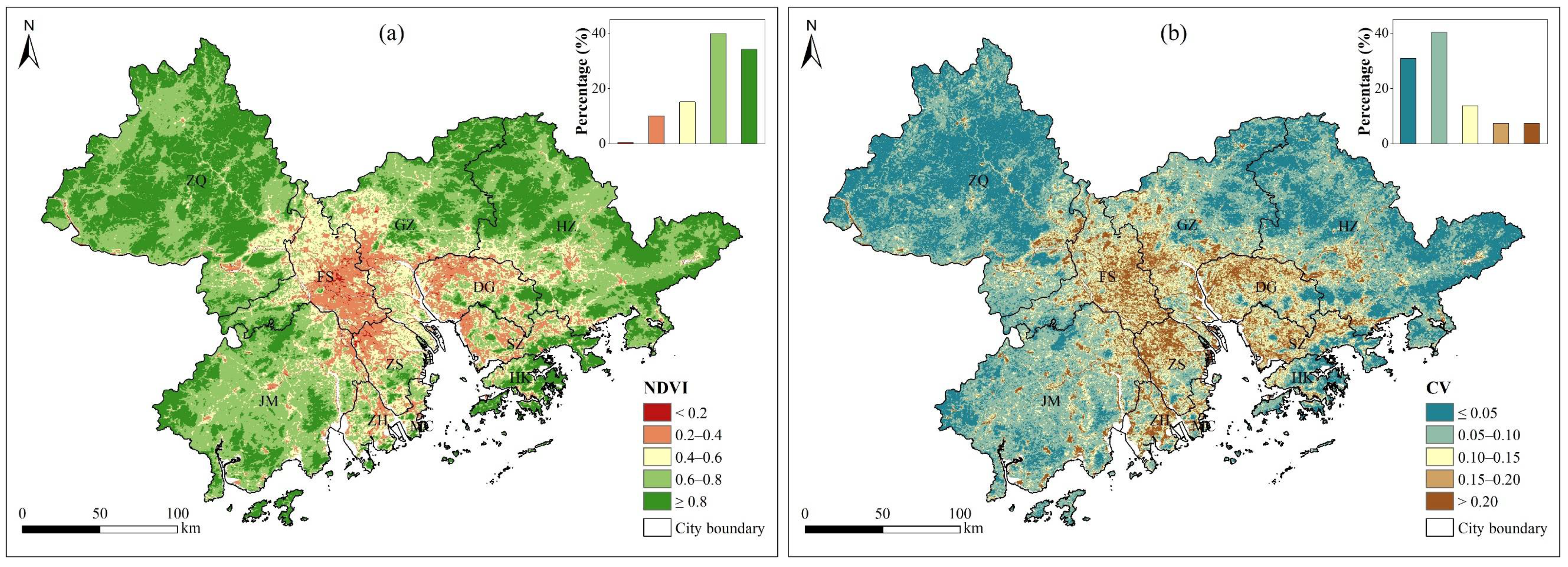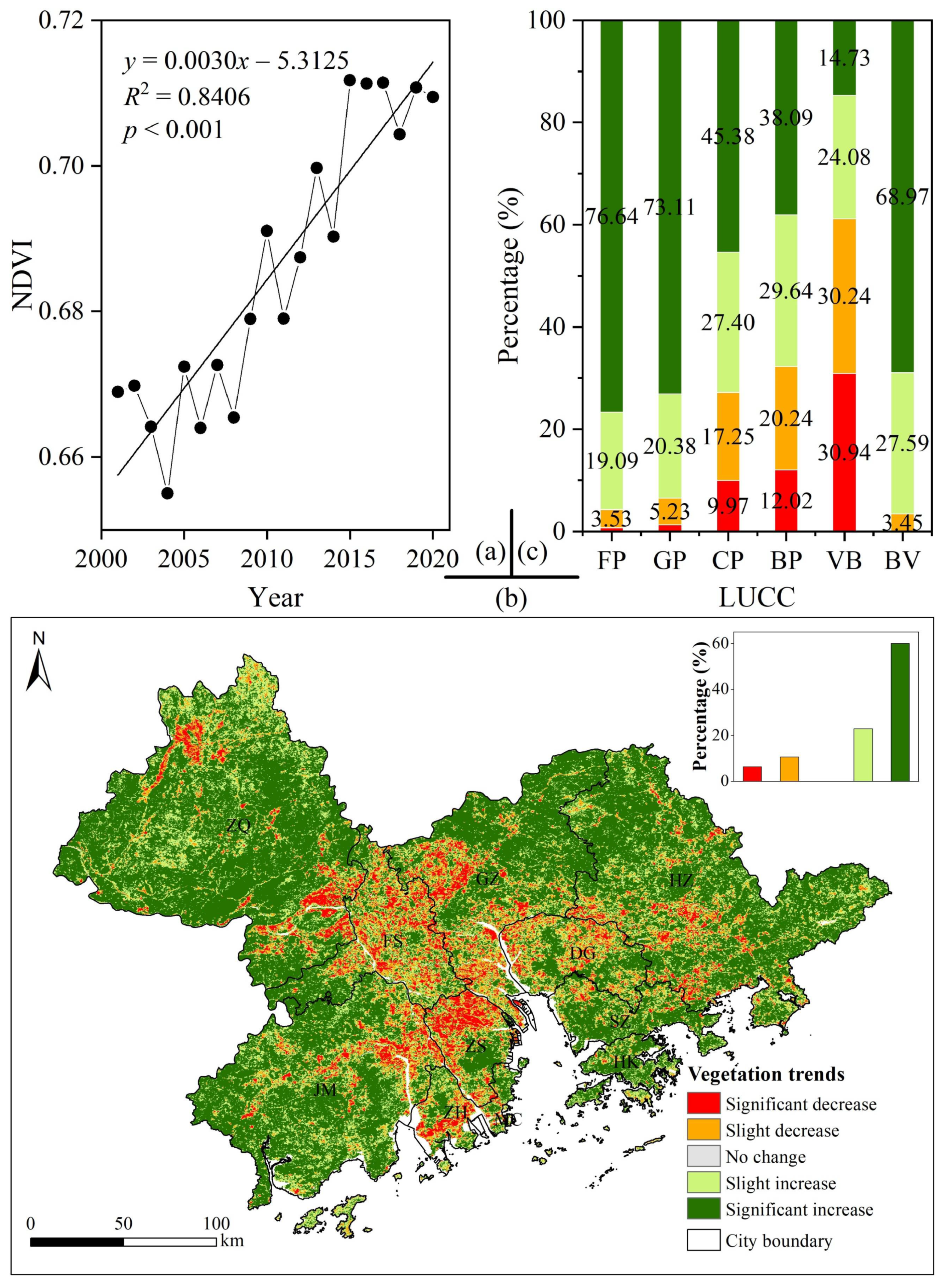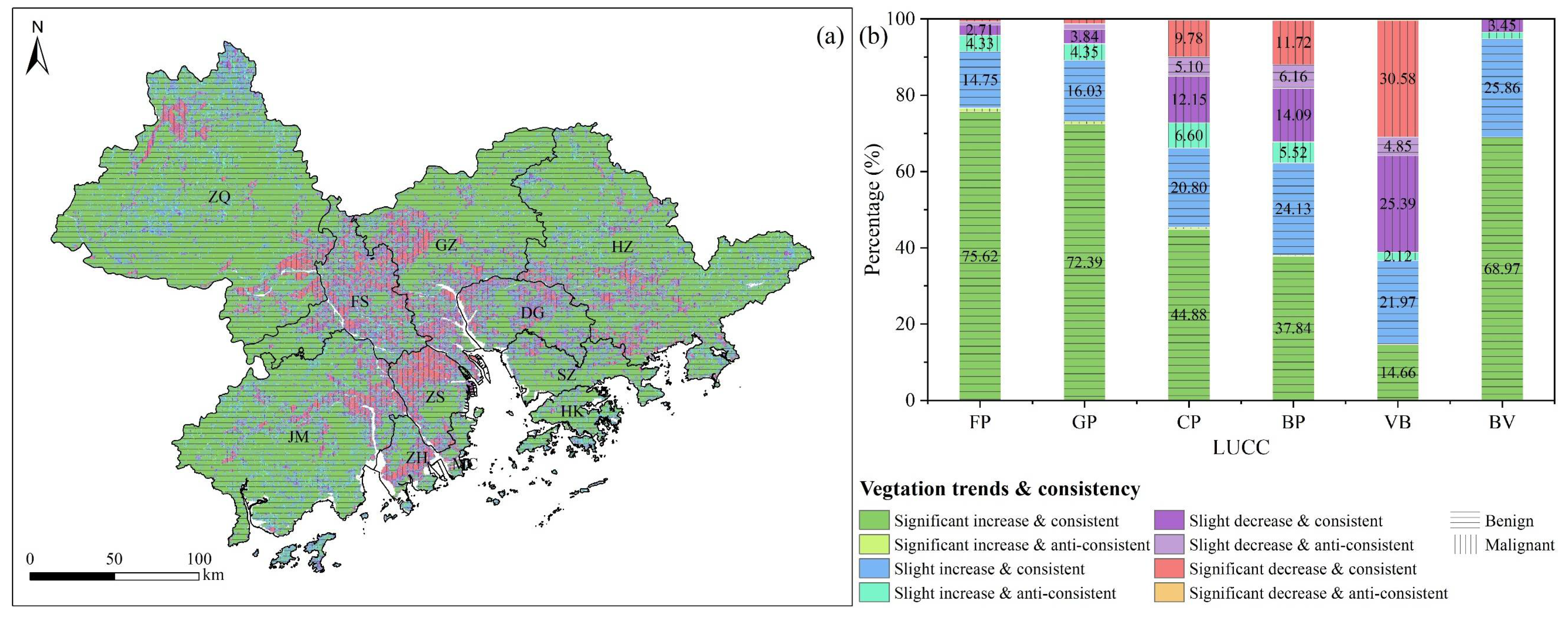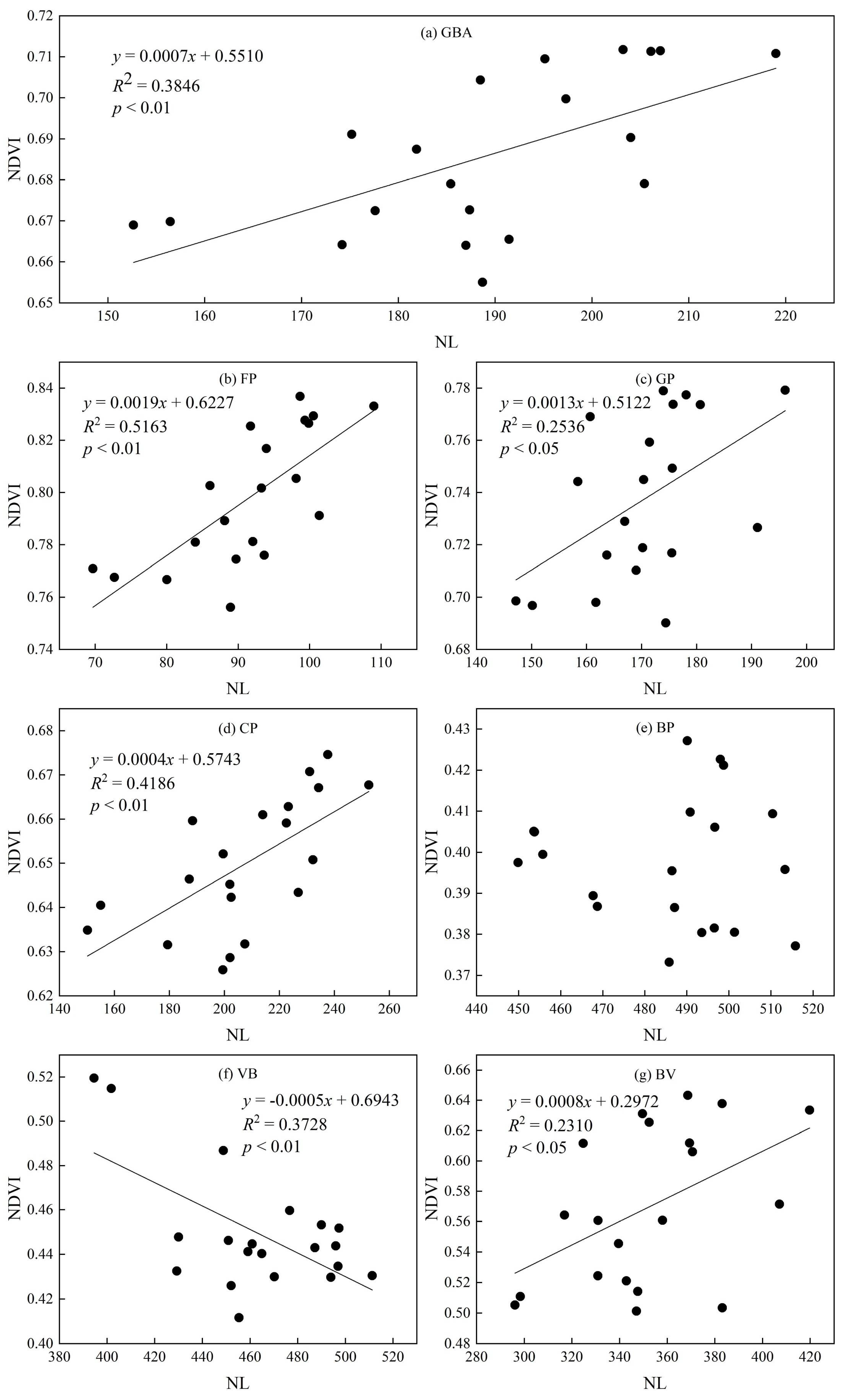Vegetation Dynamics under Rapid Urbanization in the Guangdong–Hong Kong–Macao Greater Bay Area Urban Agglomeration during the Past Two Decades
Abstract
:1. Introduction
2. Materials and Methods
2.1. Study Area
2.2. Data Source and Pre-Processing
2.2.1. NDVI Data
2.2.2. Land Use/Land Cover Data
2.2.3. Night Light Data
2.3. Methods
2.3.1. Coefficient of Variation
2.3.2. Trend Analysis
2.3.3. Hurst Exponent
2.3.4. Vegetation Dynamics of LUCC Types
2.3.5. Correlation Analysis
3. Results
3.1. Spatial Heterogeneity and Fluctuations in Vegetation Dynamics
3.2. Trends in Vegetation Dynamics
3.3. Future Changes in Vegetation Dynamics
4. Discussion
4.1. Spatiotemporal Variations in Vegetation Dynamics
4.2. Vegetation Trends among LUCC Types
4.3. Limitations and Uncertainties
5. Conclusions
Author Contributions
Funding
Acknowledgments
Conflicts of Interest
References
- Zeng, Z.Z.; Piao, S.L.; Li, L.Z.X.; Wang, T.; Ciais, P.; Lian, X.; Yang, Y.T.; Mao, J.F.; Shi, X.Y.; Myneni, R.B. Impact of Earth Greening on the Terrestrial Water Cycle. J. Clim. 2018, 31, 2633–2650. [Google Scholar] [CrossRef]
- De Carvalho, R.M.; Szlafsztein, C.F. Urban vegetation loss and ecosystem services: The influence on climate regulation and noise and air pollution. Environ. Pollut. 2019, 245, 844–852. [Google Scholar] [CrossRef] [PubMed]
- Sakaguchi, K.; Zeng, X.; Leung, L.R.; Shao, P. Influence of dynamic vegetation on carbon-nitrogen cycle feedback in the Community Land Model (CLM4). Environ. Res. Lett. 2016, 11, 124029. [Google Scholar] [CrossRef]
- Feng, H.H.; Zou, B.; Luo, J.H. Coverage-dependent amplifiers of vegetation change on global water cycle dynamics. J. Hydrol. 2017, 550, 220–229. [Google Scholar] [CrossRef]
- Port, U.; Brovkin, V.; Claussen, M. The influence of vegetation dynamics on anthropogenic climate change. Earth Syst. Dynam. 2012, 3, 233–243. [Google Scholar] [CrossRef]
- Piao, S.L.; Wang, X.H.; Park, T.; Chen, C.; Lian, X.; He, Y.; Bjerke, J.W.; Chen, A.P.; Ciais, P.; Tommervik, H.; et al. Characteristics, drivers and feedbacks of global greening. Nat. Rev. Earth Env. 2020, 1, 14–27. [Google Scholar] [CrossRef]
- Peng, J.; Liu, Z.H.; Liu, Y.H.; Wu, J.S.; Han, Y.A. Trend analysis of vegetation dynamics in Qinghai-Tibet Plateau using Hurst Exponent. Ecol. Indic. 2012, 14, 28–39. [Google Scholar] [CrossRef]
- Jiang, W.G.; Yuan, L.H.; Wang, W.J.; Cao, R.; Zhang, Y.F.; Shen, W.M. Spatio-temporal analysis of vegetation variation in the Yellow River Basin. Ecol. Indic. 2015, 51, 117–126. [Google Scholar] [CrossRef]
- Wu, X.X.; Lv, M.; Jin, Z.Y.; Michishita, R.; Chen, J.; Tian, H.Y.; Tu, X.B.; Zhao, H.M.; Niu, Z.G.; Chen, X.L.; et al. Normalized difference vegetation index dynamic and spatiotemporal distribution of migratory birds in the Poyang Lake wetland, China. Ecol. Indic. 2014, 47, 219–230. [Google Scholar] [CrossRef]
- Sarmah, S.; Jia, G.S.; Zhang, A.Z. Satellite view of seasonal greenness trends and controls in South Asia. Environ. Res. Lett. 2018, 13, 034026. [Google Scholar] [CrossRef]
- Dubovyk, O.; Landmann, T.; Erasmus, B.F.N.; Tewes, A.; Schellberg, J. Monitoring vegetation dynamics with medium resolution MODIS-EVI time series at sub-regional scale in southern Africa. Int. J. Appl. Earth Obs. Geoinf. 2015, 38, 175–183. [Google Scholar] [CrossRef]
- Zhao, L.; Dai, A.G.; Dong, B. Changes in global vegetation activity and its driving factors during 1982-2013. Agric. For. Meteorol. 2018, 249, 198–209. [Google Scholar] [CrossRef]
- Gutman, G.; Ignatov, A. The derivation of the green vegetation fraction from NOAA/AVHRR data for use in numerical weather prediction models. Int. J. Remote Sens. 1998, 19, 1533–1543. [Google Scholar] [CrossRef]
- Guay, K.C.; Beck, P.S.A.; Berner, L.T.; Goetz, S.J.; Baccini, A.; Buermann, W. Vegetation productivity patterns at high northern latitudes: A multi-sensor satellite data assessment. Glob. Change Biol. 2014, 20, 3147–3158. [Google Scholar] [CrossRef]
- Tucker, C.J. Red and photographic infrared linear combinations for monitoring vegetation. Remote Sens. Environ. 1979, 8, 127–150. [Google Scholar] [CrossRef]
- Li, J.; Wang, J.L.; Zhang, J.; Zhang, J.P.; Kong, H. Dynamic changes of vegetation coverage in China-Myanmar economic corridor over the past 20 years. Int. J. Appl. Earth Obs. Geoinf. 2021, 102, 102378. [Google Scholar] [CrossRef]
- Ruan, Z.; Kuang, Y.Q.; He, Y.Y.; Zhen, W.; Ding, S. Detecting Vegetation Change in the Pearl River Delta Region Based on Time Series Segmentation and Residual Trend Analysis (TSS-RESTREND) and MODIS NDVI. Remote Sens. 2020, 12, 4049. [Google Scholar] [CrossRef]
- Chen, C.; He, B.; Yuan, W.P.; Guo, L.L.; Zhang, Y.F. Increasing interannual variability of global vegetation greenness. Environ. Res. Lett. 2019, 14, 124005. [Google Scholar] [CrossRef]
- Fensholt, R.; Langanke, T.; Rasmussen, K.; Reenberg, A.; Prince, S.D.; Tucker, C.; Scholes, R.J.; Le, Q.B.; Bondeau, A.; Eastman, R.; et al. Greenness in semi-arid areas across the globe 1981-2007 - an Earth Observing Satellite based analysis of trends and drivers. Remote Sens. Environ. 2012, 121, 144–158. [Google Scholar] [CrossRef]
- Hu, M.M.; Xia, B.C. A significant increase in the normalized difference vegetation index during the rapid economic development in the Pearl River Delta of China. Land Degrad. Dev. 2019, 30, 359–370. [Google Scholar] [CrossRef]
- Tran, T.V.; Tran, D.X.; Nguyen, H.; Latorre-Carmona, P.; Myint, S.W. Characterising spatiotemporal vegetation variations using LANDSAT time-series and Hurst exponent index in the Mekong River Delta. Land Degrad. Dev. 2021, 32, 3507–3523. [Google Scholar] [CrossRef]
- Ndayisaba, F.; Guo, H.; Bao, A.M.; Guo, H.; Karamage, F.; Kayiranga, A. Understanding the Spatial Temporal Vegetation Dynamics in Rwanda. Remote Sens. 2016, 8, 129. [Google Scholar] [CrossRef]
- Detsch, F.; Otte, I.; Appelhans, T.; Hemp, A.; Nauss, T. Seasonal and long-term vegetation dynamics from 1-km GIMMS-based NDVI time series at Mt. Kilimanjaro, Tanzania. Remote Sens. Environ. 2016, 178, 70–83. [Google Scholar] [CrossRef]
- Yuan, J.; Xu, Y.P.; Xiang, J.; Wu, L.; Wang, D.Q. Spatiotemporal variation of vegetation coverage and its associated influence factor analysis in the Yangtze River Delta, eastern China. Environ. Sci. Pollut. R 2019, 26, 32866–32879. [Google Scholar] [CrossRef] [PubMed]
- Imhoff, M.L.; Bounoua, L.; DeFries, R.; Lawrence, W.T.; Stutzer, D.; Tucker, C.J.; Ricketts, T. The consequences of urban land transformation on net primary productivity in the United States. Remote Sens. Environ. 2004, 89, 434–443. [Google Scholar] [CrossRef]
- Du, J.Q.; Quan, Z.J.; Fang, S.F.; Liu, C.C.; Wu, J.H.; Fu, Q. Spatiotemporal changes in vegetation coverage and its causes in China since the Chinese economic reform. Environ. Sci. Pollut. R 2020, 27, 1144–1159. [Google Scholar] [CrossRef] [PubMed]
- Zhao, S.Q.; Liu, S.G.; Zhou, D.C. Prevalent vegetation growth enhancement in urban environment. Proc. Natl. Acad. Sci. USA 2016, 113, 6313–6318. [Google Scholar] [CrossRef] [PubMed]
- Pei, F.S.; Li, X.; Liu, X.P.; Wang, S.J.; He, Z.J. Assessing the differences in net primary productivity between pre- and post-urban land development in China. Agric. For. Meteorol. 2013, 171, 174–186. [Google Scholar] [CrossRef]
- Gregg, J.W.; Jones, C.G.; Dawson, T.E. Urbanization effects on tree growth in the vicinity of New York City. Nature 2003, 424, 183–187. [Google Scholar] [CrossRef] [PubMed]
- Xue, P.; Liu, H.Y.; Zhang, M.Y.; Gong, H.B.; Cao, L. Nonlinear Characteristics of NPP Based on Ensemble Empirical Mode Decomposition from 1982 to 2015-A Case Study of Six Coastal Provinces in Southeast China. Remote Sens. 2022, 14, 15. [Google Scholar] [CrossRef]
- Taubenböck, H.; Weigand, M.; Esch, T.; Staab, J.; Wurm, M.; Mast, J.; Dech, S. A new ranking of the world’s largest cities-Do administrative units obscure morphological realities? Remote Sens. Environ. 2019, 232, 111353. [Google Scholar] [CrossRef]
- Ma, Y.L.; Zhang, S.H.; Yang, K.; Li, M.C. Influence of spatiotemporal pattern changes of impervious surface of urban megaregion on thermal environment: A case study of the Guangdong-Hong Kong-Macao Greater Bay Area of China. Ecol. Indic. 2021, 121, 107106. [Google Scholar] [CrossRef]
- Lan, S.X.; Dong, Z.J. Incorporating Vegetation Type Transformation with NDVI Time-Series to Study the Vegetation Dynamics in Xinjiang. Sustainability 2022, 14, 582. [Google Scholar] [CrossRef]
- Jiang, C.; Wu, Z.F.; Cheng, J.; Yu, Q.; Rao, X.Q. Impacts of urbanization on net primary productivity in the Pearl River Delta, China. Int. J. Plant Prod. 2015, 9, 581–598. [Google Scholar]
- Yan, Y.C.; Liu, X.P.; Wang, F.Y.; Li, X.; Ou, J.P.; Wen, Y.Y.; Liang, X. Assessing the impacts of urban sprawl on net primary productivity using fusion of Landsat and MODIS data. Sci. Total Environ. 2018, 613, 1417–1429. [Google Scholar] [CrossRef] [PubMed]
- Hu, M.M.; Li, Z.T.; Wang, Y.F.; Jiao, M.Y.; Li, M.; Xia, B.C. Spatio-temporal changes in ecosystem service value in response to land-use/cover changes in the Pearl River Delta. Resour. Conserv. Recycl. 2019, 149, 106–114. [Google Scholar] [CrossRef]
- Jonsson, P.; Eklundh, L. TIMESAT - a program for analyzing time-series of satellite sensor data. Comput. Geosci. 2004, 30, 833–845. [Google Scholar] [CrossRef]
- Zhang, L.X.; Ren, Z.H.; Chen, B.; Gong, P.; Fu, H.H.; Xu, B. A Prolonged Artificial Nighttime-light Dataset of China (1984–2020). 2021. [Google Scholar] [CrossRef]
- Sen, P.K. Estimates of the Regression Coefficient Based on Kendall’s Tau. J. Am. Stat. Assoc. 1968, 63, 1379–1389. [Google Scholar] [CrossRef]
- Theil, H. A Rank-Invariant Method of Linear and Polynomial Regression Analysis I, II, and III. Proc. K. Ned. Akad. Wet. 1950, 53, 386–392, 521–525, 1397–1412. [Google Scholar] [CrossRef]
- Kendall, M. Rank Correlation Methods; Charles Griffin: London, UK, 1975. [Google Scholar]
- Hurst, H.E. Long-Term Storage Capacity of Reservoirs. Trans. Am. Soc. Civ. Eng. 1951, 116, 770–799. [Google Scholar] [CrossRef]
- Barunik, J.; Kristoufek, L. On Hurst exponent estimation under heavy-tailed distributions. Physica A 2010, 389, 3844–3855. [Google Scholar] [CrossRef]
- Xu, F.; Zhou, Y.Y.; Zhao, L.L. Spatial and temporal variability in extreme precipitation in the Pearl River Basin, China from 1960 to 2018. Int. J. Climatol. 2022, 42, 797–816. [Google Scholar] [CrossRef]
- Liu, W.; Zhan, J.Y.; Zhao, F.; Yan, H.M.; Zhang, F.; Wei, X.Q. Impacts of urbanization-induced land-use changes on ecosystem services: A case study of the Pearl River Delta Metropolitan Region, China. Ecol. Indic. 2019, 98, 228–238. [Google Scholar] [CrossRef]
- Zhang, Y.H.; Ye, A.Z. Quantitatively distinguishing the impact of climate change and human activities on vegetation in mainland China with the improved residual method. Gisci. Remote Sens. 2021, 58, 235–260. [Google Scholar] [CrossRef]
- Moore, I.D.; Grayson, R.B.; Ladson, A.R. Digital Terrain Modeling—a Review of Hydrological, Geomorphological, and Biological Applications. Hydrol. Process. 1991, 5, 3–30. [Google Scholar] [CrossRef]
- Geng, S.B.; Shi, P.L.; Zong, N.; Zhu, W.R. Using soil survey database to assess soil quality in the heterogeneous Taihang Mountains, north China. Sustainability 2018, 10, 3443. [Google Scholar] [CrossRef]
- Qiu, B.W.; Li, W.J.; Zhong, M.; Tang, Z.H.; Chen, C.C. Spatiotemporal analysis of vegetation variability and its relationship with climate change in China. Geo Spat. Inf. Sci. 2014, 17, 170–180. [Google Scholar] [CrossRef]
- Wu, Y.Z.; Tang, G.P.; Gua, H.; Liu, Y.L.; Yang, M.Z.; Sun, L. The variation of vegetation greenness and underlying mechanisms in Guangdong province of China during 2001-2013 based on MODIS data. Sci. Total Environ. 2019, 653, 536–546. [Google Scholar] [CrossRef]
- Liu, H.X.; Han, B.L.; Wang, L. Modeling the spatial relationship between urban ecological resources and the economy. J. Clean Prod. 2018, 173, 207–216. [Google Scholar] [CrossRef]
- Shipigina, E.; Rees, W.G. Analysis of human impact on boreal vegetation around Monchegorsk, Kola peninsula, using automated remote sensing technique. Polar. Rec. 2012, 48, 94–106. [Google Scholar] [CrossRef]
- Yu, W.J.; Zhou, W.Q.; Dawa, Z.; Wang, J.; Qian, Y.G.; Wang, W.M. Quantifying Urban Vegetation Dynamics from a Process Perspective Using Temporally Dense Landsat Imagery. Remote Sens. 2021, 13, 3217. [Google Scholar] [CrossRef]
- Zhu, Z.; Fu, Y.C.; Woodcock, C.E.; Olofsson, P.; Vogelmann, J.E.; Holden, C.; Wang, M.; Dai, S.; Yu, Y. Including land cover change in analysis of greenness trends using all available Landsat 5, 7, and 8 images: A case study from Guangzhou, China (2000–2014). Remote Sens. Environ. 2016, 185, 243–257. [Google Scholar] [CrossRef]
- Zhang, L.; Yang, L.; Zohner, C.M.; Crowther, T.W.; Li, M.C.; Shen, F.X.; Guo, M.; Qin, J.; Yao, L.; Zhou, C.H. Direct and indirect impacts of urbanization on vegetation growth across the world’s cities. Sci. Adv. 2022, 8, eabo0095. [Google Scholar] [CrossRef]
- Wang, M.X.; Zhao, H.H.; Cui, J.X.; Fan, D.; Lv, B.; Wang, G.; Li, Z.H.; Zhou, G.J. Evaluating green development level of nine cities within the Pearl River Delta, China. J. Clean Prod. 2018, 174, 315–323. [Google Scholar] [CrossRef]
- Feng, D.R.; Bao, W.K.; Yang, Y.Y.; Fu, M.C. How do government policies promote greening? Evidence from China. Land Use Pol. 2021, 104, 105389. [Google Scholar] [CrossRef]
- Los, S.O. Analysis of trends in fused AVHRR and MODIS NDVI data for 1982-2006: Indication for a CO2 fertilization effect in global vegetation. Glob. Biogeochem. Cy. 2013, 27, 318–330. [Google Scholar] [CrossRef]
- Greaver, T.L.; Clark, C.M.; Compton, J.E.; Vallano, D.; Talhelm, A.F.; Weaver, C.P.; Band, L.E.; Baron, J.S.; Davidson, E.A.; Tague, C.L.; et al. Key ecological responses to nitrogen are altered by climate change. Nat. Clim. Change 2016, 6, 836–843. [Google Scholar] [CrossRef]
- de la Barrera, F.; Henriquez, C. Vegetation cover change in growing urban agglomerations in Chile. Ecol. Indic. 2017, 81, 265–273. [Google Scholar] [CrossRef]
- Esau, I.; Miles, V.V.; Davy, R.; Miles, M.W.; Kurchatova, A. Trends in normalized difference vegetation index (NDVI) associated with urban development in northern West Siberia. Atmos. Chem. Phys. 2016, 16, 9563–9577. [Google Scholar] [CrossRef]
- Liu, J.G.; Li, S.X.; Ouyang, Z.Y.; Tam, C.; Chen, X.D. Ecological and socioeconomic effects of China’s policies for ecosystem services. Proc. Natl. Acad. Sci. USA 2008, 105, 9477–9482. [Google Scholar] [CrossRef]
- Huang, Y.S.; Li, P.; An, Q.; Mao, F.J.; Zhai, W.C.; Yu, K.F.; He, Y.L. Long-term land use/cover changes reduce soil erosion in an ionic rare-earth mineral area of southern China. Land Degrad. Dev. 2021, 32, 4042–4055. [Google Scholar] [CrossRef]
- Cao, R.F.; Zhang, A.L.; Wen, L.J. Trans-regional compensation mechanism under imbalanced land development: From the local government economic welfare perspective. Habitat Int. 2018, 77, 56–63. [Google Scholar] [CrossRef]
- Shang, W.X.; Gong, Y.C.; Wang, Z.J.; Stewardson, M.J. Eco-compensation in China: Theory, practices and suggestions for the future. J. Environ. Manage. 2018, 210, 162–170. [Google Scholar] [CrossRef]
- Zhang, Y.; Yao, Y.T.; Wang, X.H.; Liu, Y.W.; Piao, S.L. Mapping spatial distribution of forest age in China. Earth Space Sci. 2017, 4, 108–116. [Google Scholar] [CrossRef]
- Chen, C.; Park, T.; Wang, X.H.; Piao, S.L.; Xu, B.D.; Chaturvedi, R.K.; Fuchs, R.; Brovkin, V.; Ciais, P.; Fensholt, R.; et al. China and India lead in greening of the world through land-use management. Nat. Sustain. 2019, 2, 122–129. [Google Scholar] [CrossRef] [PubMed]
- Liu, Y.X.; Wang, Y.L.; Du, Y.Y.; Zhao, M.Y.; Peng, J. The application of polynomial analyses to detect global vegetation dynamics during 1982-2012. Int. J. Remote Sens. 2016, 37, 1568–1584. [Google Scholar] [CrossRef]
- Fang, X.Q.; Zhu, Q.A.; Ren, L.L.; Chen, H.; Wang, K.; Peng, C.H. Large-scale detection of vegetation dynamics and their potential drivers using MODIS images and BFAST: A case study in Quebec, Canada. Remote Sens. Environ. 2018, 206, 391–402. [Google Scholar] [CrossRef]
- Chu, H.S.; Venevsky, S.; Wu, C.; Wang, M.H. NDVI-based vegetation dynamics and its response to climate changes at Amur-Heilongjiang River Basin from 1982 to 2015. Sci. Total Environ. 2019, 650, 2051–2062. [Google Scholar] [CrossRef]





| LULC Type | 2020 LULC (km2) | Total | ||||||
|---|---|---|---|---|---|---|---|---|
| Built-Up | Cropland | Forest | Grassland | Waterbody | Unutilized Land | |||
| 2000 LULC (km2) | Built-up | persistent | 0.69 (0.02%) | 1.97 (0.05%) | 0.59 (0.01%) | 1.23 (0.03%) | 0 (0%) | 4.49 (0.11%) |
| Cropland | 2663.23 (64.65%) | persistent | 2.07 (0.05%) | 11.34 (0.28%) | 9.66 (0.23%) | 0 (0%) | 2686.30 (65.21%) | |
| Forest | 815.80 (19.81%) | 3.80 (0.09%) | persistent | 16.10 (0.39%) | 10.48 (0.25%) | 0 (0%) | 846.18 (20.54%) | |
| Grassland | 50.41 (1.22%) | 0.15 (<0.01%) | 0 (0%) | persistent | 0.83 (0.02%) | 0 (0%) | 51.40 (1.24%) | |
| Waterbody | 398.16 (9.67%) | 3.61 (0.09%) | 2.27 (0.06%) | 1.14 (0.03%) | persistent | 0 (0%) | 405.17 (9.85%) | |
| Unutilized Land | 95.27 (2.31%) | 0 (0%) | 1.83 (0.04%) | 3.52 (0.09%) | 25.07 (0.61%) | persistent | 125.69 (3.05%) | |
| Total | 4022.86 (97.66%) | 8.24 (0.20%) | 8.15 (0.20%) | 32.70 (0.80%) | 47.28 (1.14%) | 0 (0%) | 4119.23 (100%) | |
| Variable 1 | Grade | Area (%) of LUCC 2 | |||||
|---|---|---|---|---|---|---|---|
| FP | GP | CP | BP | VB | BV | ||
| NDVI | <0.2 | 0 | 0.01 | 0.05 | 2.27 | 0.50 | 0 |
| 0.2–0.4 | 0.17 | 0.43 | 4.94 | 57.12 | 36.64 | 3.45 | |
| 0.4–0.6 | 2.36 | 8.33 | 23.19 | 29.38 | 51.04 | 56.90 | |
| 0.6–0.8 | 37.67 | 63.38 | 67.59 | 11.07 | 11.58 | 39.65 | |
| ≥0.8 | 59.79 | 27.85 | 4.23 | 0.16 | 0.24 | 0 | |
| CV | ≤0.05 | 49.00 | 23.00 | 15.77 | 1.63 | 0.41 | 0 |
| 0.05–0.10 | 43.18 | 57.91 | 56.09 | 17.26 | 8.20 | 13.79 | |
| 0.10–0.15 | 6.07 | 13.81 | 17.42 | 36.26 | 27.36 | 51.72 | |
| 0.15–0.20 | 1.29 | 3.66 | 6.37 | 28.52 | 27.41 | 15.52 | |
| >0.20 | 0.46 | 1.62 | 4.35 | 16.33 | 36.62 | 18.97 | |
| Trend Analysis | Hurst Exponent | Future Development | Area Percentage (%) | |||
|---|---|---|---|---|---|---|
| SNDVI | Z | H | Trend and Consistency | Direction | ||
| SNDVI > 0 | |Z| > 1.96 | 0.5 < H < 1 | Significant increase and consistent | Benign | 59.28 | 80.06 |
| SNDVI > 0 | |Z| ≤ 1.96 | 0.5 < H < 1 | Slight increase and consistent | 17.93 | ||
| SNDVI < 0 | |Z| ≤ 1.96 | 0 < H < 0.5 | Slight decrease and anti-consistent | 2.74 | ||
| SNDVI < 0 | |Z| > 1.96 | 0 < H < 0.5 | Significant decrease and anti-consistent | 0.11 | ||
| SNDVI > 0 | |Z| > 1.96 | 0 < H < 0.5 | Significant increase and anti-consistent | Malignant | 0.74 | 19.94 |
| SNDVI > 0 | |Z| ≤ 1.96 | 0 < H < 0.5 | Slight increase and anti-consistent | 5.04 | ||
| SNDVI < 0 | |Z| ≤ 1.96 | 0.5 < H < 1 | Slight decrease and consistent | 7.91 | ||
| SNDVI < 0 | |Z| > 1.96 | 0.5 < H < 1 | Significant decrease and consistent | 6.25 | ||
Publisher’s Note: MDPI stays neutral with regard to jurisdictional claims in published maps and institutional affiliations. |
© 2022 by the authors. Licensee MDPI, Basel, Switzerland. This article is an open access article distributed under the terms and conditions of the Creative Commons Attribution (CC BY) license (https://creativecommons.org/licenses/by/4.0/).
Share and Cite
Geng, S.; Zhang, H.; Xie, F.; Li, L.; Yang, L. Vegetation Dynamics under Rapid Urbanization in the Guangdong–Hong Kong–Macao Greater Bay Area Urban Agglomeration during the Past Two Decades. Remote Sens. 2022, 14, 3993. https://doi.org/10.3390/rs14163993
Geng S, Zhang H, Xie F, Li L, Yang L. Vegetation Dynamics under Rapid Urbanization in the Guangdong–Hong Kong–Macao Greater Bay Area Urban Agglomeration during the Past Two Decades. Remote Sensing. 2022; 14(16):3993. https://doi.org/10.3390/rs14163993
Chicago/Turabian StyleGeng, Shoubao, Huamin Zhang, Fei Xie, Lanhui Li, and Long Yang. 2022. "Vegetation Dynamics under Rapid Urbanization in the Guangdong–Hong Kong–Macao Greater Bay Area Urban Agglomeration during the Past Two Decades" Remote Sensing 14, no. 16: 3993. https://doi.org/10.3390/rs14163993






